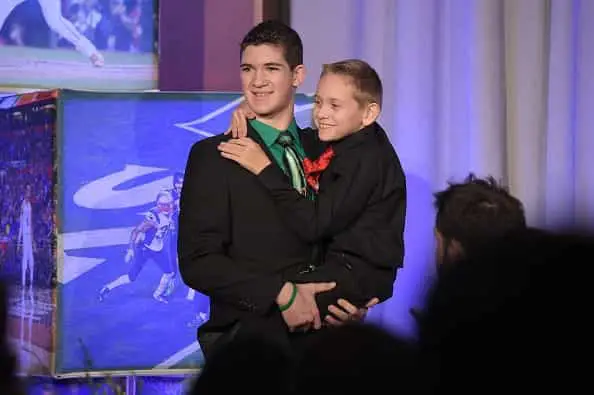It’s no surprise that kids who grow up with a sibling with cerebral palsy tend be a little more stressed when compared to children who don’t live with someone with the disorder. However, they’re often more well-adjusted than their peers and more empathetic and caring towards people with special needs. Kids who help take care of their disabled sibling also tend to have higher self-esteem and a sense of pride. The following inspirational stories shows just how powerful a relationship between a child with cerebral palsy and siblings can be.
Hunter and Braden Gandee

One of the most inspirational stories of all time is that of Hunter Gandee, a Michigan teenager who, in 2016, carried his special needs brother on his back for 111 miles to help spread awareness about children with disabilities.
Hunter’s brother, Braden Gandee, 9, was diagnosed with cerebral palsy at age 1. His disability prohibits him from walking without the assistance of a walker, and makes it difficult for him to communicate effectively. Knowing how important it was for Braden to feel welcomed among his peers, Hunter took Braden off his back just before they reached the Michigan Capitol during their 11-mile trek, and Braden, using his walker, stepped across the finish.
It’s an inspiration for siblings everywhere who may wonder what they can do to help their own brother or sister. Not only did Hunter and Braden raise awareness about disabilities, but last year, when they participated in a similar event, and raised over $100,000 for a playground at Braden’s elementary school. According to Hunter,
“I wanted to show people the struggles that Braden has to go through daily. I wanted to go out and show people we can make the world a better place for people with cerebral palsy.”
Ashton and Michael Kutcher

Most people recognize Ashton Kutcher from his movie roles and television roles on shows such as That 70s Show and Two and a Half Men. What many may not realize is that the actor has a twin brother who was diagnosed with cerebral palsy at age three.
Ashton recalled that while growing up, he would play basketball with his brother, who gave up after not making a “right hand” shot. As Michael walked away, Ashton stopped him and gave him advice that would change his brother’s life forever. According to Michael,
“I said, ‘You know I can’t make that shot. It’s not fair.’ And Chris (Ashton) even at that age said, ‘You can do anything you want. I can’t make that shot for you. Mom’s not here; she can’t do it for you. It’s your challenge. Stop using your disability as a crutch. This is your obstacle.’”
Years later, at age 13, Michael had a heart attack and was given a grim prognosis.. As a doctor pumped his heart, his parents were told that it would only extend his life for 48 hours. Miraculously, a donor arrived 24 hours later. Michael survived. He remembered Ashton’s words which helped him move on to become his own self, and not a shadow of his charming brother who would go on to model in New York and star in award-winning shows.
“I realized that was my challenge, my obstacle to overcome.”
Conner and Cayden Long
In 2011, when Conner Long was only a 7-year-old, he found a way to play with his brother Cayden Long, 5, and at the same time, raise awareness for cerebral palsy. Cayden was diagnosed with cerebral palsy at 4-months-old.

With the help of their mother, Conner and Cayden participated in their first Triathlon at the Nashville Kids Triathlon. The competition entailed several different competitions, including Conner riding a bike while pulling Cayden in a pedicab, swimming while pulling Cayden in a raft, and running while pulling Cayden in a stroller.
Although the boys didn’t win the competition, they developed an unbreakable bond, and the excitement of the competition convinced them to keep going. A few weeks later, they participated in another race in downtown Nashville. They began training and upgraded their racing equipment, and eventually went on to compete in the largest Triathlon for kids in the nation, the IronKids Triathlon.
Conner’s dedication to his brother landed them on the 2012 Sports Illustrated Kids issue, “SportsKids of the Year.”
Advice for Kids With Siblings Who Have Cerebral Palsy
Siblings don’t have to compete in long-distance runs or Triathlons to help their brother and sister with cerebral palsy, although these stories certainly help spark inspiration and help kids relate with other kids who have siblings with cerebral palsy. Including children with disabilities in everyday activities and treating them as an individual and a not a kid with cerebral palsy helps them feel loved and connected.
If you have a sibling with cerebral palsy, just being there for them and including them in the things you do will do wonders for their self-esteem and image. Remember, underneath the disability is a child just as yourself, wanting to play and a part of their peer group just as any other kid would.

